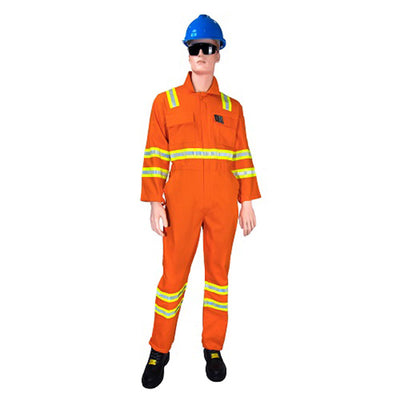Fire Retardant Coverall - Buy Fire Proof Coveralls at Best Prices

Fire Retardant Coverall 260 GSM - European Style
Features:
- Fire Retardant Coverall 260 GSM
- With 2 inches dual tone (Grey/Fluorescent Yellow) FR reflective tape
- 1 inch tape on both sleeves & legs, adjustable velcro cuff with button wrist closures, 2 way heavy duty metal zipper with 2 chest snaps and storm flap, 2 chest pockets
- FR Coverall 260 GSM (Test report available)
- Sanforized and mercerized
Applications & Properties : Welding, Heat & Limited Flame Spread, Electrostatic Properties.

Fire Retardant Coverall 320 GSM | European Style
Features:
- Fire Retardant Coverall 320 GSM | European Style
- With 2 inches dual tone (Grey/Fluorescent Yellow) FR reflective tape
- 1 inch tape on both sleeves & legs, adjustable velcro cuff with button wrist closures, 2 way heavy duty metal zipper with 2 chest snaps and storm flap, 2 chest pockets
- Sanforized and mercerized
- FR Coverall 320 GSM (Test report available)
Applications & Properties : Welding, Heat & Limited Flame Spread, Electrostatic Properties.
Fire retardant coveralls
Fire retardant coveralls are specialized clothing designed to provide protection from fire and other thermal hazards. They are made from fabrics that are treated with fire retardant chemicals or woven from inherently flame-resistant fibers. Fire retardant coveralls are commonly used in industries where workers are exposed to high heat, flame, or other hazards, such as firefighting, welding, oil and gas, and electrical utilities.
Features of fire retardant coveralls
Fire retardant coveralls are typically made from heavy-duty fabrics that are designed to resist burning or melting in the presence of high heat or flame. The fabrics are often treated with fire retardant chemicals that are designed to prevent the spread of flames or reduce the intensity of a fire. Fire retardant coveralls may also feature additional layers of insulation or reflective materials to protect against radiant heat.
Usage of fire retardant coverall
Fire retardant coveralls are used in a variety of industries where workers are at risk of exposure to fire, heat, or other thermal hazards. These industries include firefighting, welding, oil and gas, electrical utilities, and chemical processing. Fire retardant coveralls provide an extra layer of protection for workers, reducing the risk of burns, injuries, or fatalities in the event of a fire or other thermal hazard.
Benefits of fire retardant coverall
The primary benefit of fire retardant coveralls is their ability to protect workers from thermal hazards. By reducing the risk of burns and other injuries, fire retardant coveralls can improve worker safety and productivity. Fire retardant coveralls can also reduce the risk of property damage and liability for employers, as they can help prevent fires from spreading or causing more extensive damage.
Types of fire retardant coveralls
There are several different types of fire retardant coveralls, each with its own unique properties and applications. Some of the most common types of fire retardant coveralls include:
Inherently flame-resistant coveralls: These coveralls are made from fibers that are inherently resistant to flame, such as aramid, modacrylic, or wool. These fibers do not require the addition of fire retardant chemicals, making them less likely to degrade over time or lose their effectiveness.
Treated fire retardant coveralls: These coveralls are made from fabrics that have been treated with fire retardant chemicals, such as halogenated compounds or phosphorus-based materials. These chemicals are designed to interrupt the combustion process and prevent the spread of flames.
Multi-hazard coveralls: These coveralls are designed to provide protection from multiple types of hazards, such as fire, electrical arcs, and chemical exposure. Multi-hazard coveralls may be made from a combination of flame-resistant fabrics, insulating materials, and chemical-resistant coatings.
Disposable coveralls: These coveralls are designed for single use and are often made from lightweight, breathable fabrics. Disposable coveralls are commonly used in situations where workers may be exposed to hazardous materials or where there is a risk of contamination.
In short, fire retardant coveralls are an essential component of worker safety in industries where workers are exposed to high heat or flames. By providing an extra layer of protection, fire retardant coveralls can reduce the risk of injuries, property damage, and liability for employers. With a variety of types and applications available, fire retardant coveralls are a versatile and effective solution for protecting workers in hazardous environments.



